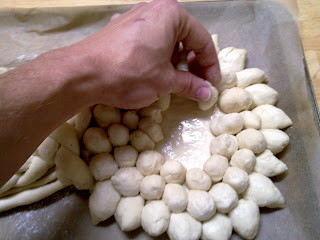~Garfield
As the weather gets colder my cooking shifts to heavier, heartier fare. Stews and baked dishes make regular appearances. Not only are they warming and filling, they also make for wonderful leftovers that get better and better each time they are reheated. A favourite in our house is lasagna. This recipe, although more time consuming than using a canned red-sauce, is well worth the effort. And the amount of sauce you end up with is more than you need for the lasagna itself so the leftover can be used as a sauce for spaghetti or other pasta dish.
Lasagna
1 pound ground beef
3/4 pound ground pork
As the weather gets colder my cooking shifts to heavier, heartier fare. Stews and baked dishes make regular appearances. Not only are they warming and filling, they also make for wonderful leftovers that get better and better each time they are reheated. A favourite in our house is lasagna. This recipe, although more time consuming than using a canned red-sauce, is well worth the effort. And the amount of sauce you end up with is more than you need for the lasagna itself so the leftover can be used as a sauce for spaghetti or other pasta dish.
Lasagna
1 pound ground beef
3/4 pound ground pork
1 Tbs butter
1 Tbs olive oil
1/2 medium onion, minced
6 cloves garlic, crushed
1 (28 ounce) can crushed tomatoes
2 (6 ounce) cans tomato paste
2 (6.5 ounce) cans canned tomato sauce
1 Tbs sugar
1½ tsp dried basil leaves
1 Tbs salt
1/4 tsp ground black pepper
4 Tbs chopped fresh parsley
12 lasagna noodles
16 ounces ricotta cheese
1 egg
1/2 tsp salt
1 pound mozzarella cheese, sliced
3/4 cup grated Parmesan cheese
In a large pan, cook the ground beef and ground pork over medium heat until lightly browned. Drain off excess grease.
6 cloves garlic, crushed
1 (28 ounce) can crushed tomatoes
2 (6 ounce) cans tomato paste
2 (6.5 ounce) cans canned tomato sauce
1 Tbs sugar
1½ tsp dried basil leaves
1 Tbs salt
1/4 tsp ground black pepper
4 Tbs chopped fresh parsley
12 lasagna noodles
16 ounces ricotta cheese
1 egg
1/2 tsp salt
1 pound mozzarella cheese, sliced
3/4 cup grated Parmesan cheese
In a large pan, cook the ground beef and ground pork over medium heat until lightly browned. Drain off excess grease.
In a Dutch oven, melt butter and olive oil. Add the onion and garlic and saute until transparent. Add browned meat and stir in crushed tomatoes, tomato paste and tomato sauce.
Season with the sugar, basil, 1 Tbs salt, pepper, and 2 Tbs parsley.
Simmer, covered, for about 1½ to 2 hours, stirring occasionally.
Simmer, covered, for about 1½ to 2 hours, stirring occasionally.
Prepare the noodles as per package directions.
In a mixing bowl, combine ricotta cheese with egg, remaining parsley and 1/2 tsp salt. Mix well.
Preheat oven to 375° F.
Cut the mozzarella cheese into thick slices.
Spread 1½ cups of the meat sauce in the bottom of a 9-inch by 13-inch baking dish. Arrange six noodles lengthwise over the meat sauce. Spread one half of the ricotta cheese mixture on top of the meat sauce. Top with a third of mozzarella cheese slices. Spoon 1½ cups of the meat sauce over mozzarella, and sprinkle with 1/4 cup Parmesan cheese. Arrange remaining six noodles lengthwise over the meat sauce. Repeat layers, and top with remaining mozzarella and Parmesan cheese.
Cover with foil.
Bake at 375° F for 25 minutes. Remove foil, and bake an additional 25 minutes.
In a mixing bowl, combine ricotta cheese with egg, remaining parsley and 1/2 tsp salt. Mix well.
Preheat oven to 375° F.
Cut the mozzarella cheese into thick slices.
Spread 1½ cups of the meat sauce in the bottom of a 9-inch by 13-inch baking dish. Arrange six noodles lengthwise over the meat sauce. Spread one half of the ricotta cheese mixture on top of the meat sauce. Top with a third of mozzarella cheese slices. Spoon 1½ cups of the meat sauce over mozzarella, and sprinkle with 1/4 cup Parmesan cheese. Arrange remaining six noodles lengthwise over the meat sauce. Repeat layers, and top with remaining mozzarella and Parmesan cheese.
Cover with foil.
Bake at 375° F for 25 minutes. Remove foil, and bake an additional 25 minutes.















